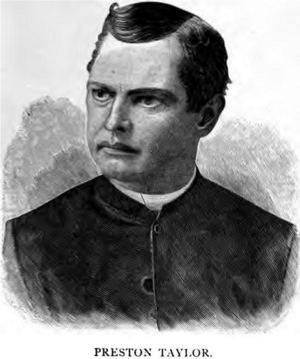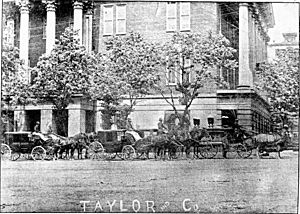Preston Taylor facts for kids
Quick facts for kids
Preston Taylor
|
|
|---|---|

Image of Taylor from 1887
|
|
| Born | November 7, 1849 |
| Died | April 13, 1931 (age 81) |
| Resting place | Greenwood Cemetery |
| Occupation | businessman minister philanthropist |
|
Notable work
|
Foundation of Greenwood Cemetery and Greenwood Park |
| Spouse(s) | Georgia Gordon Ida D. Mallory |
| Religion | Christian Church |
Preston Taylor (born November 7, 1849 – died April 13, 1931) was an important African-American businessman, minister, and helper of his community (a philanthropist). In the early 1900s, he was seen as one of the most important leaders for the black community in Nashville, Tennessee. He started Greenwood Cemetery, a burial ground for African Americans. He also created Greenwood Park, which was the first park for black communities in Nashville. A public housing area was later named after him.
Contents
Preston Taylor's Life Story
Early Years and Freedom
Preston Taylor was born into slavery in Shreveport, Louisiana, on November 7, 1849. His parents were Zed and Betty Taylor. When he was just four years old, he told his mother he wanted to be a preacher.
In 1864, during the American Civil War, he joined the army. He was a drummer in the 116th Regiment Infantry U.S. Colored Troops. He was part of important battles like the Siege of Petersburg and the fall of Richmond. He was also there when General Lee surrendered. After the war ended in 1865, his army unit was in Texas and New Orleans. There, he was officially set free.
After the war, Taylor became a marble engraver, someone who carves designs into marble. He moved to Louisville, Kentucky. White workers in Kentucky refused to work with him. So, he found a job as a train porter for the Louisville & Chattanooga Railroad. He worked there for four years.
Becoming a Minister and Community Leader
After leaving the railroad, Taylor traveled around the northern states. When he returned to Kentucky, he felt called to become a pastor. Around 1870, he became a minister with the Christian Church (Disciples of Christ) and settled in Mount Sterling, Kentucky.
In 1874, he started the High Street Christian Church. It was known as a beautiful brick church and became the largest church of its kind in the state. Taylor became a leading minister. He helped organize and build many other churches and meeting places.
Taylor's work also led to the creation of state and national groups for black churches. In 1872, he helped start the Kentucky Christian Missionary Convention. He also helped create the national black Disciples organization.
He strongly believed in education for black people. In the mid-1880s, he bought land for a college in New Castle, Kentucky. He created the Christian Bible College at New Castle. He later helped manage its money. He was also chosen to be a general evangelist for the entire U.S. He even wrote a section in a church newspaper called "Our Colored Brethren."
Even though black people faced many challenges in business after the Civil War, Taylor found success. He got a contract to build parts of a railroad track from Mt. Sterling to Richmond, Virginia. The contractors first refused to hire black workers. But Taylor's success impressed the railroad president, Collis Potter Huntington. Huntington asked Taylor to advise other contractors. However, Taylor chose to stay home to continue his preaching.
Moving to Nashville
In 1884, Preston Taylor moved to Nashville, Tennessee. He quickly became one of the city's most important African-American business and religious leaders.
He married Georgia Gordon Taylor (1855–1913), who was one of the original Fisk Jubilee Singers. She was the daughter of George Gordon, who was enslaved, and Mercy Duke Gordon. At 18, Georgia toured Europe and the U.S. with the Fisk University singers. After her tour, she married Taylor. They had a son in 1891, but he died as a baby. Georgia continued singing until her death in 1913. She was Taylor's closest friend. After she passed away, Taylor married his second wife, Ida D. Mallory.
Taylor became the minister of Gay Street Christian Church, which was the black congregation connected to the Vine Street First Christian Church. In 1891, he and a group left the Gay Street church. They started a new church in an office building. In 1903, they finished building their own church. Taylor was the pastor of this church for 40 years, until he died in 1931. After his death, the two churches joined together. They are now called the New Covenant Christian Church.
In 1917, Taylor helped create the National Christian Missionary Convention. This was a national group for African-American Disciples of Christ churches. He was the president of this group from when it started until he died.
Taylor was involved in many businesses. He became a very rich man through his business activities. He was seen as one of the most powerful and important African-American businessmen in Nashville in the early 1900s. He helped start the first black bank, One Cent (Citizen's) Savings and Trust Company Banks. In 1909, he was a key person in starting Tennessee State Agricultural and Industrial State Normal College. This was a state-supported college for African Americans, which is now Tennessee State University.
In 1887, he bought 37 acres of land for $30,000. There, he started Greenwood Cemetery in 1888. He said it would be a good quality, low-cost cemetery for African Americans. Greenwood Cemetery is the second oldest cemetery for black people in Nashville. At the same time, he started the Taylor Funeral Company, a funeral home.
Helping the Community (Philanthropy)
In 1905, Preston Taylor created Greenwood Park. This was a fun park for African-American communities. It covered about 37.5 acres. It was the first park for Nashville's African-American residents. At that time, black people were not allowed to use public parks. Greenwood Park had gardens, fountains, a bandstand, and a baseball field. The yearly "State Colored Fair" was held there. He even arranged for horse-drawn wagons to take people from the streetcar to the park. The park stayed open until 1949.
He left Greenwood Cemetery to the National Christian Missionary Convention of the Christian Church (Disciples of Christ). It is still a non-profit organization today.
Later Life and Recognition
Until his death on April 13, 1931, Taylor was the most well-known African-American citizen in Nashville. Taylor was buried in Greenwood Cemetery after a week-long ceremony.
In 1951, a public housing project in Nashville was named Preston Taylor Housing in his honor. It is now known as the Historic Preston Taylor Apartments. That part of Nashville also has the Preston Taylor YMCA and Preston Taylor Ministries.


